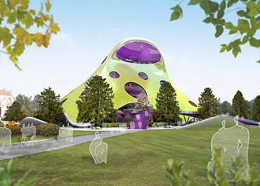
Ten years after the blob's failure, library management is betting on a different solution
 |
The then-director of the National Library, Vlastimil Ježek, aimed to address the spatial shortcomings of the institution with a new building. However, the competition, endorsed by the International Union of Architects, ended up in court because the rules changed during its course. The jury defended itself by stating that the competition organizer could not imagine ensuring that the books in the underground storage would withstand all hazards, as Kaplický ultimately proposed. However, the new building was mainly buried by politicians and officials who found the criticism of the blob useful in their political battles.
 |
Last year, the National Library created a document proposing several options for the library's future operation after the major revitalization of Klementinum, which will not be completed before 2019. The projections again consider a new building in the broader center of Prague. Petr Kroupa, tasked with managing the National Library, previously told ČTK regarding his predecessors' decision to replace the new building with the completion of the central storage facility: "The whole system is wrong; surely everyone can see that." However, he will leave the decision on the new building to his successor. Today, he stated that the priority now is the revitalization of Klementinum and the completion and reconstruction of the existing storage facility.
In Prague, apart from the National Technical Library, which was quietly built during the disputes over Kaplický's blob, no public building for cultural purposes has been constructed. There has been talk for years about a new concert hall, a new building for the National Gallery, or a building for the Slav Epic. Primarily, however, the state invests only in the reconstruction of buildings predominantly from the 19th century that house national cultural institutions. If new cultural spaces are being created, they are backed by the private sector. Outside of Prague, the situation is different, but in Prague, only a few storage facilities have been built with state money, which cannot be considered public buildings and are mostly not architecturally significant.
The competition for the National Library building was one of the few public competitions in the cultural field held in Prague. The Czech Chamber of Architects criticizes the fact that initiators of buildings or reconstructions do not resort to them. According to the chamber, the competition is the most effective tool for preparing a transparent selection and saving public money. However, last year saw the most competitions announced in the past 25 years, reported Zuzana Hošková, spokeswoman for the chamber, to ČTK.
There were 54 competitions for the modification of public spaces, territorial studies, or spaces for educational and state institutions. Among the investors were cities, regions, the Prague Zoo, and state museums. Despite the significant increase, architectural competitions remain a marginal form of public procurement. In the overall volume of announced investments, they represent only one percent.
The English translation is powered by AI tool. Switch to Czech to view the original text source.
0 comments
add comment
Related articles
0
17.01.2019 | Prague will not continue the preparation of the library according to Kaplický
0
16.10.2018 | Prague will create a feasibility study for the construction of a blob in Letná
0
03.07.2014 | Will Herman resurrect the library project in Letná?
8
13.04.2010 | Fans of the blob believe that the film could reopen the debate about it
25
13.01.2010 | Prague definitively rejects the blob at Letná












